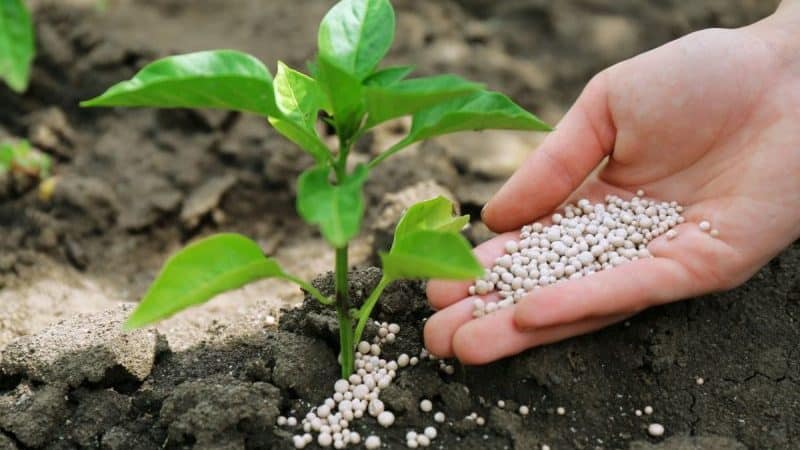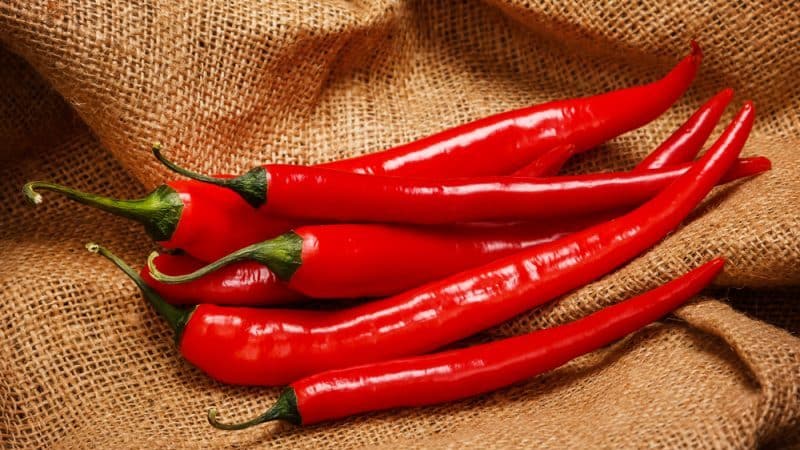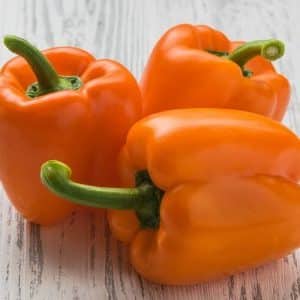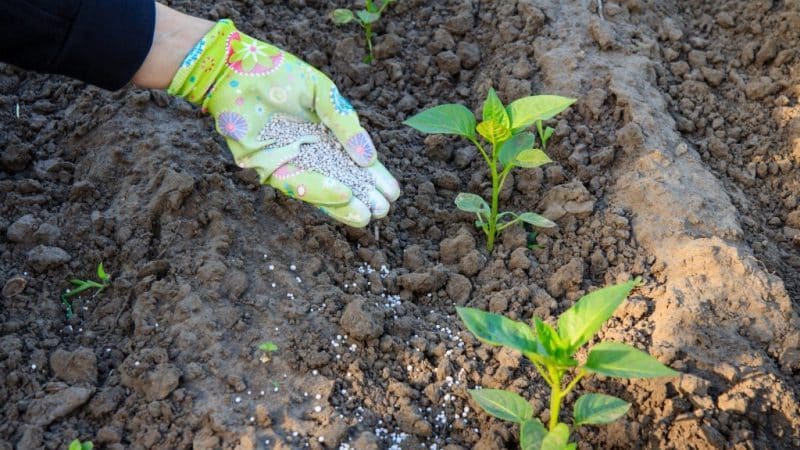How to feed peppers during flowering and fruiting in a greenhouse to obtain a record harvest
High-quality and timely fertilizing increases the yield of peppers. With proper care, you can reap a rich harvest even in regions with a cold climate. Today we’ll figure out how to feed peppers during flowering and fruiting in a greenhouse.
Features of fertilization
In regions with cool climates, peppers are grown in greenhouses. They create favorable conditions for the growth and development of nightshade crops: temperature, lighting, humidity and fertilized soil.
Fertilizing in a greenhouse is no different from the fertilizers that plants require in open ground. Gardeners contribute the same nutrients: potassium, nitrogen, phosphorus, calcium and magnesium.
The quality and quantity of the harvest depends on how correctly and timely the pepper was fertilized during the flowering and fruiting period.
Fertilizing peppers during flowering and fruiting
Depending on the ripening phase, peppers need fertilizing containing different substances. Both natural fertilizers and single-component and multi-component minerals are used.
Organic fertilizers
Organic products provide the crop with the necessary nutrients in the early stages of development. They improve soil structure and fight diseases.
The most popular folk recipes:
- Ash is rich in potassium and phosphorus. This organic fertilizer is produced by burning weeds, wood and other plant residues.Wood ash affects the development of the plant, strengthens it, and the fruits become juicy. To fertilize the peppers, prepare an infusion: 1 tbsp. l. wood ash is added to 2 liters of warm water. The solution is infused in a dark place for 24 hours, then filtered through cheesecloth and watered over the peppers. They use ash that does not contain combustion products of garbage (plastic and polyethylene) and painted wood.
- Iodine has a beneficial effect on nightshade crops. The substance increases productivity and stimulates plant growth. Iodine is a good antiseptic. For feeding, prepare a solution: dilute 1-2 drops of iodine in 1 liter of water and add 100 ml of whey.
- Bird droppings. The infusion is used to feed nightshade crops in the early stages of development. Bird droppings are rich in nitrogen, so they are used to increase tops. The solution is prepared as follows: take two parts of water for one part of the substance, mix and leave for 2-3 days. During this time, the solution will have time to ferment. Before feeding the plants, the infusion is diluted in water in a ratio of 1:10.
Purchased fertilizers
Mineral fertilizers are applied at each phase of plant development. Stores sell both single-component (containing one substance) and complex (composed of several substances):
- Phosphorus. From the moment the sprouts appear, peppers are given fertilizers containing this substance. Thanks to him, they begin to grow faster. Plants receive energy and their metabolic processes increase. Superphosphate is considered an excellent mineral fertilizer for vegetables. It contains about 20% phosphorus. The solution is well absorbed by plants. Gardeners receive a rich harvest.
- Nitrogen. With a lack of nitrogen, the leaves become pale green or pale yellow.To compensate for the lack of nitrogen, fertilize with manure or urea. Ammonium nitrate is also rich in this substance.
- Potassium. With a lack of potassium, the leaves begin to curl. In this case, potassium sulfate fertilizer is suitable. Calimagnesia is considered a good supplement. It accelerates plant growth.
- Multicomponent fertilizers. Complex mixtures compensate for the lack of several substances at once. "Gumi" is a fertilizer for adult plants. It improves the growth and development of peppers and increases protection against pests. Contains potassium, phosphorus, nitrogen, sodium salts.
Which fertilizer to choose
Gardeners advise using organic and mineral fertilizers for fertilizer.
During flowering
During active flowering, fertilizers with a high nitrogen content are applied. If the plant lacks this substance, the leaves begin to darken and wrinkle. Fertilizers with nitrogen are applied by drops or in dry form:
- Ammonium nitrate. This substance contains salts of nitric acid. Thanks to them, greenery grows. Add 15 g of substance to 10 liters of water. For each bush use 0.5 liters of solution.
- Nettle infusion. Organic fertilizer has a beneficial effect on the plant. It helps fight pests and diseases and stimulates growth. The infusion is prepared as follows: 100 grams of dried leaves are poured into 3 liters of warm water and infused in a warm place before the fermentation process begins. When it starts, cover the lid with polyethylene. Leave it in this state for two weeks. The finished infusion is diluted in water (two parts of water are used for one part of the solution and 2 tablespoons of ash are added) and the plants are watered.
- During the flowering period, humus will be a good way to feed. It is diluted with water in a ratio of 1:5. Plants are watered with the solution.Apply once.
Important! You cannot use an infusion of humus and manure at the same time. This will harm the plant.
During fruit set
For fruit set, fertilizing with a high potassium content is used:
- Calimagnesia. Mineral fertilizer accelerates plant growth. For 10 liters of water use 30 g of the substance and 6 g of ammonium nitrate.
- Potassium sulfide. This mixture contains about 50% potassium. The feeding solution is prepared as follows: add 5 g of the substance, 5 g of urea and 10 g of potassium monophosphate to 10 liters of water.
- To stimulate fruit set, use the “Dachnik” fertilizer. It is applied dry under each bush in the amount specified in the instructions. After this, the ground is watered.
During fruiting
During the fruiting period, calcium is added to the basic nutrients. It affects the formation of fruits. If the plant lacks calcium, the peppers will not be juicy.
An excellent means of feeding is calcium nitrate. It strengthens the fruit. A solution iodine at this stage it improves the taste of the peppers.
Feeding with superphosphate is carried out during the period of active fruiting. Fertilizers are applied directly to the roots of plants. The solution is prepared as follows: 10 g of the substance, 20 g of calcium nitrate and 5 g of potassium sulfate are dissolved in 10 liters of water. This feeding makes the fruits strong and juicy.
Features of choosing fertilizer for bell and hot peppers

Fertilizers are selected based on the variety. In regions with cool climates, gardeners grow sweet (Bulgarian) and hot peppers.
Sweet (bell) peppers grow in fertile soil rich in nitrogen, potassium, magnesium, phosphorus and calcium. Chlorine should not be present in the soil. For good growth, plants use root fertilizers.

Excellent fertilizer for bell pepper - manure. Liquid manure is dissolved in water in a ratio of 1:5. Per sq. m use 5-6 liters of infusion.
Yeast, ash, banana peels (contains phosphorus, potassium, calcium), boric acid, eggshells, onion peels, and herbal infusion are used as organic fertilizers.
Hot peppers in the greenhouse are fed weekly when the first ovary appears. Use fertilizers based on pine ash, fertilizers containing phosphorus and nitrogen.
Hot peppers are fed once every 10 days with chicken manure and potassium, or a Nitrophoska solution is prepared (35 g diluted in 10 liters of water).
Terms and rules for fertilizing
During the season, 6-7 fertilizing is applied: three main ones, the rest - additional ones.
Basic feeding:
- The first is introduced two weeks after planting the seedlings in the greenhouse. At this time, the plants begin to bloom.
- The second is carried out during the formation of the ovaries. If the first feeding was using mineral fertilizers, the second is carried out with organic substances.
- The third is applied during fruiting. Use fertilizers that dissolve well in water.
Gardeners use two methods for applying fertilizers: root and foliar.
Root
With the root method, solutions are applied under the root in liquid form or into the ground before planting the seedlings in the greenhouse.
Egg shells are considered an excellent fertilizer. It is laid in the ground before planting seedlings. But an infusion is also prepared from it: the shells of no more than three eggs are crushed and 3 liters of water are poured. The solution is infused for four days, and then young and adult plants are watered with it.
Foliar
Foliar feeding is carried out if the plant signals that it lacks nutrients. The lack of elements is determined by the appearance of the bush.
If the crop grows poorly, it is sprayed with a urea solution. For 10 liters of water use 1 tsp. substances.
Calcium nitrate is suitable for rapid fruit formation. The bushes are irrigated with a solution of the substance (20 g of the substance per 10 liters of water). This solution is enough for 1-1.5 square meters. m.
Interesting! How to treat a plant that has developed blossom end rot? This question is asked by beginning gardeners. In this case, calcium nitrate will help. Each bush is watered with a solution (0.2%). Use one liter per plant.
Precautionary measures
When feeding peppers in a greenhouse, observe the following precautions:
- The frequency of fertilization is influenced by the composition of the soil, the type of crop and the place of cultivation. On fertile soils in regions with warm climates, fertilizers are applied no more than five times, taking into account the condition of the plants. Excessive fertilizing leads to the fact that the crop gets sick and dies.
- Buy fertilizers in specialized stores and from reliable sellers.
- Foliar feeding is kept to a minimum. Fertilizers are poured directly under the bush. If the solution gets on the leaves, wipe them with a damp cloth.
- When feeding plants with ammonia, wear gloves and a respirator. Ammonia is a toxic substance that causes poisoning.
Advice from experienced summer residents

To ensure that plants grow well and gardeners get a decent harvest with juicy fruits, experienced agronomists give the following advice:
- Apply fertilizing 1-2 days after watering to moist soil. When fertilizing with dry complex mixtures, repeat watering after applying fertilizers.
- Alternate mineral and organic fertilizers every week. This way the fruits ripen faster.
- To prepare infusions, use only warm, settled water not colder than +21°C.
- Fertilize in the morning or evening and combine with watering.
- If the ovaries fall off, treat the plants with boric acid. Dissolve 5 g of the substance in 10 liters of warm water and fertilize using irrigation.
- To increase yield, use yeast feeding. It contains microelements such as iron, vitamins, phosphorus and nitrogen.
Read also:
We choose the best fertilizer for radishes and apply the fertilizer correctly.
What is the benefit of feeding cucumbers with ammonia and how to use it correctly.
Conclusion
High-quality and timely feeding of plants will provide the gardener with a large harvest at the end of the season. To feed peppers, root and foliar methods are used. The emphasis is on the root method of fertilizing. This method allows you to deliver all the necessary nutrients to the root without damaging the leaves.
During flowering, the fruits are fertilized with nitrogen substances, and during the formation of ovaries - with potassium. During the fruiting period, calcium is added to the main nutrients. It participates in the formation of fruits and improves the taste of peppers.
On average, peppers are fertilized three times per season. Additional nutrients are added only in case of their shortage. Deficiency is indicated by the appearance of plants.